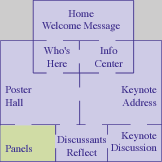Posted by:
Mark St. John
Posted on: May 08, 2002 at 1:00 PM
Message:
Reeny... I appreciate your comments and ideas. Your question about what can intermediary organizations like ASSET do to help initiate the process of developing an II (improvement infrastructure) is a key question. It also very much a bootstrap question -- that is, to do the work you at ASSET want to do, you need to have the II present, and so to do the work you need to do, you have to create the very structure you are counting on...and that structure can not be yours, it must be the district's...So ultimately, I guess, my answer is that this work can NOT be and should not be done by intermediary organizations... It must originate in and be owned by the system itself... But that does not mean we can not help it along... First, I think we (projects, funders, and evaluators) should be much more aware of and careful about the danger of our reform work actually lessening the perceived need for an internal II... That is, are we leading a Sup to say: Good, now I dont have to invest our money in science... that is already well funded by NSF... we can use our scarce resources elsewhere... Too much temporary soft money can actually weaken the system long-term.... Second, we can structure our grants so that they begin with the assumption that the grant is intended to support existing II assets in doing their work... That is, it may be a mistake to build a whole temporary structure... as many LSCs do...and then somehow hope the district will see the light and continue to support it after the grant is gone... Maybe (I am guessing here) it would be possible to fund only existing infrastructre... or at least match existing infrastructure... so that there would be more incentive for districts to have assets that could get them into the funding game... (I recognize there are many problems with this idea...) Finally, we can all do more to create and reenforce the idea that there should be an II in every district, even school... And here NSF could really help... Rather than focusing solely on student achievement as an outcome of its funding, NSF could demand visible rigorous evidence that their grants are contributing to and putting to work II assets. That is, develop criteria and evaluate grants on the basis of their contribution to long standing II and use of existing II... Making public the level of investment, the number of people, the level of work done to bolster improvement may be the first step in creating the need for II... Focusing solely on "outcomes" as measured in student achievement is a sure way to diminish the focus on the II... (This happens in industry as well -- focus on this quarter's profits and you will end up cutting your R and D department...) Finally, just using the term... and including it in our language may be very important as a first step toward making visible a need that is completely invisible at the moment. The nation as a whole is demanding increased student achievement... and we are beginning to realize that such achievement may require "quality teachers..." But we have not yet realized that those quality teachers require highly skilled people, resources, and structures to produce the professional development etc to assure that quality... That is the argument that has to be made visible...
|


